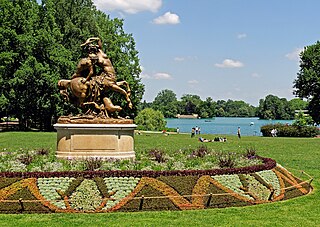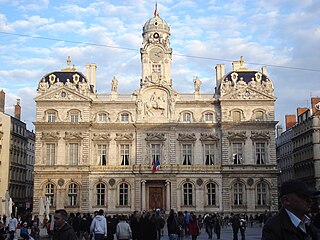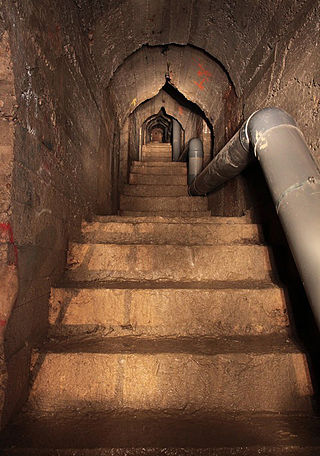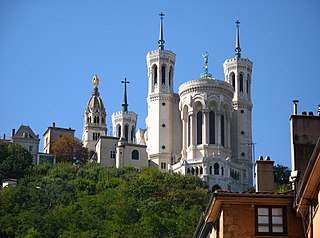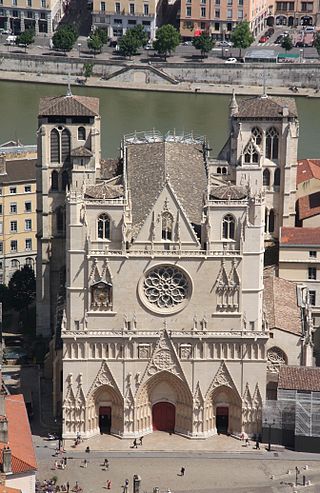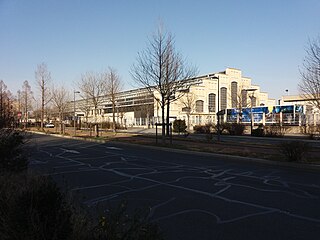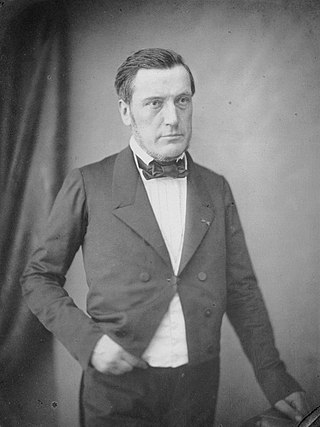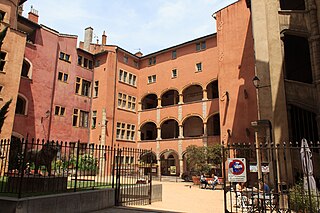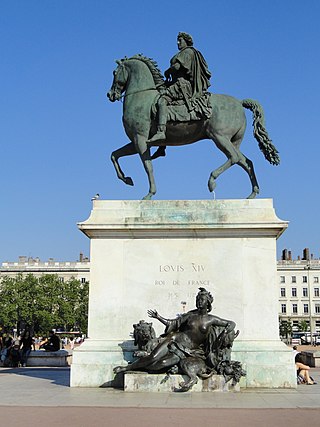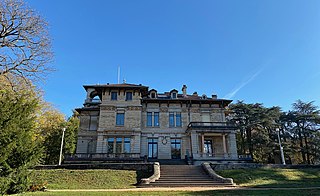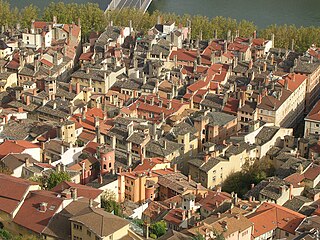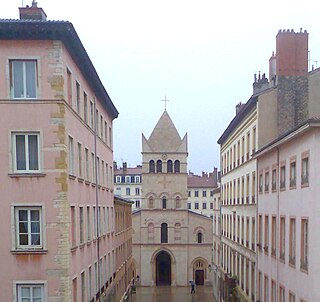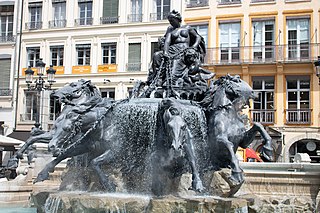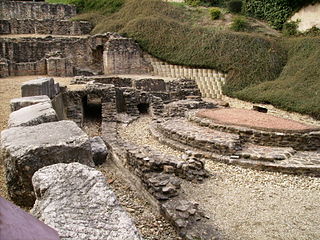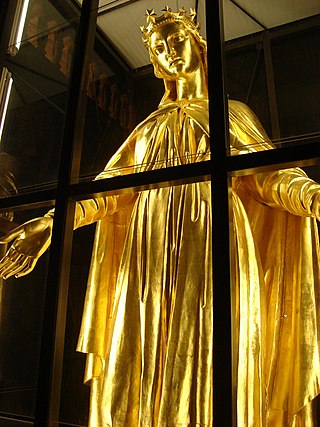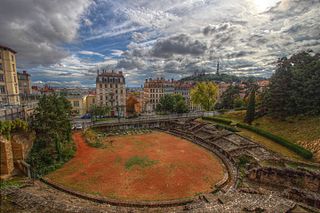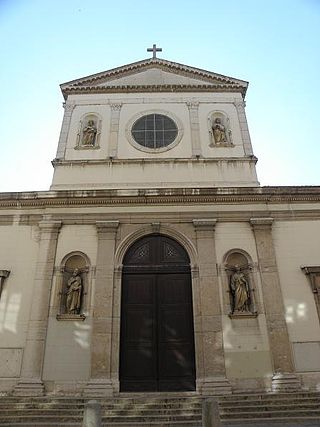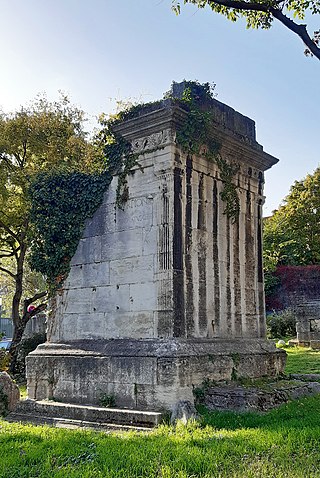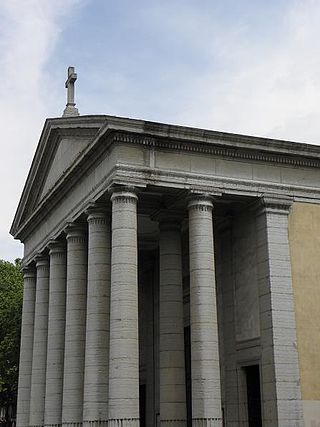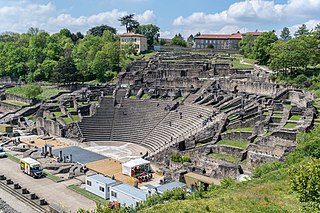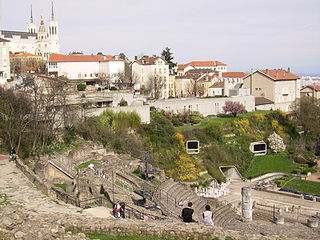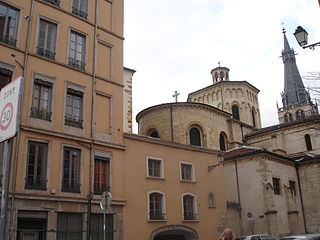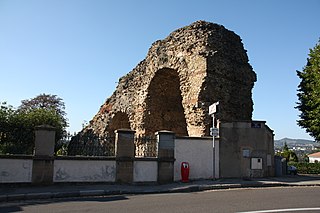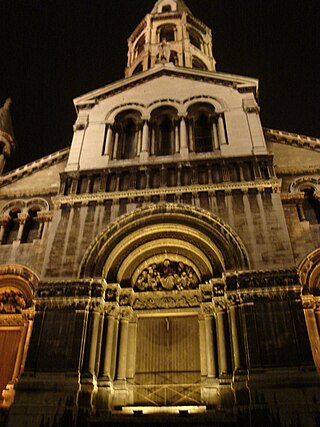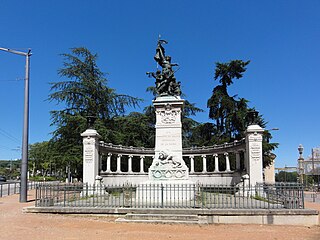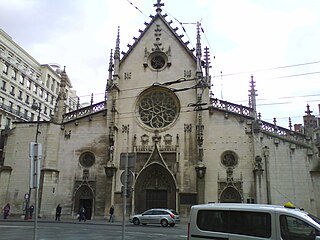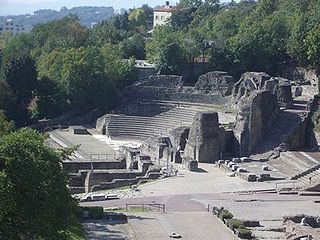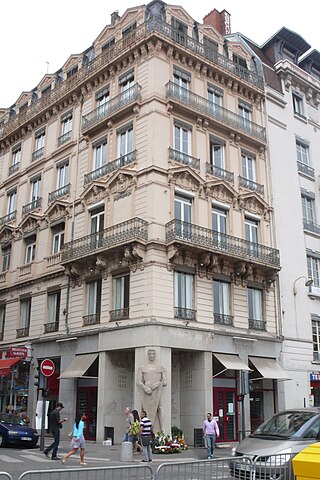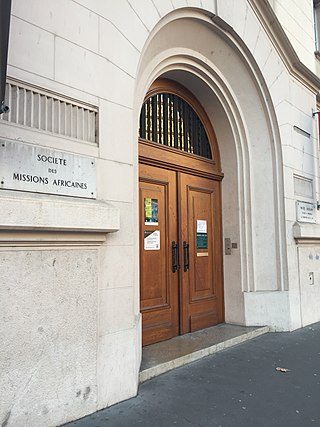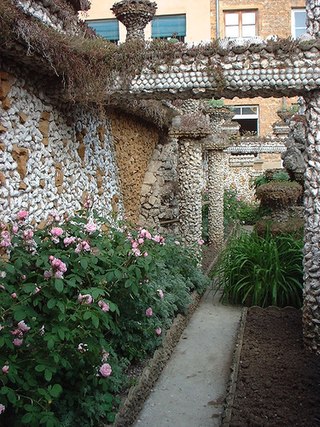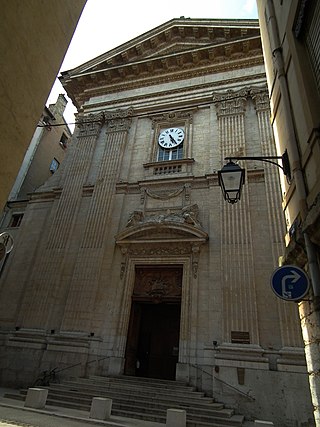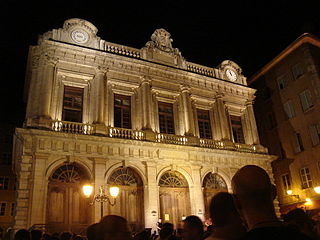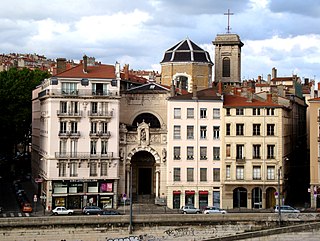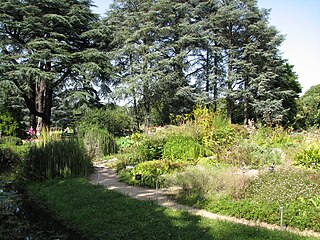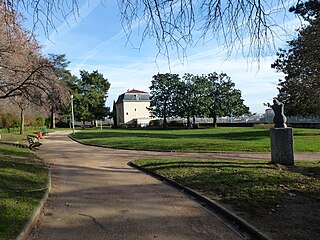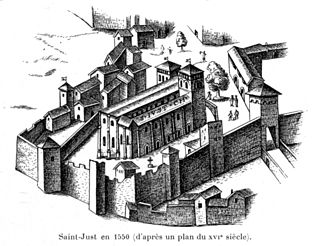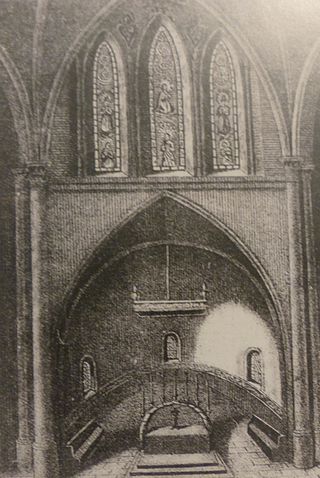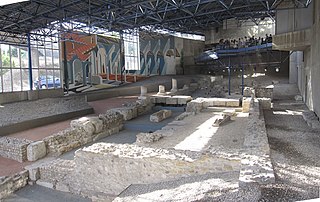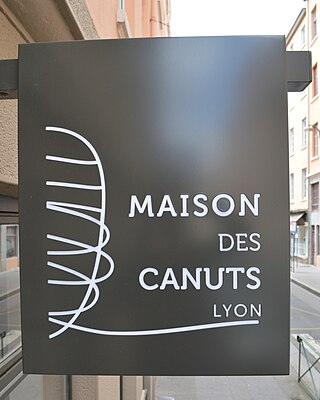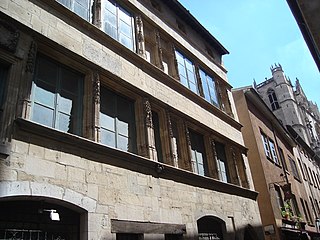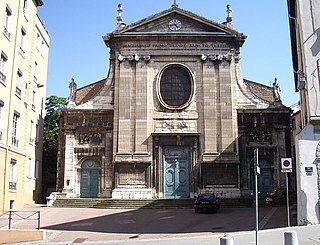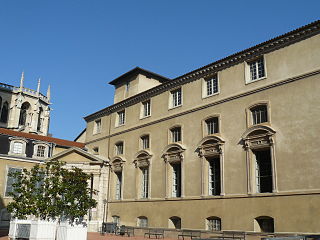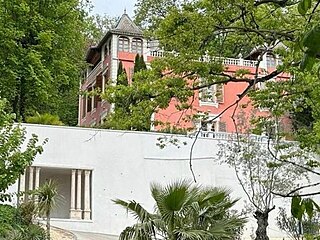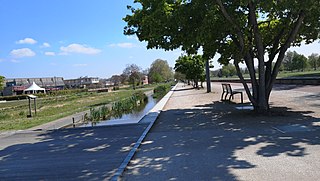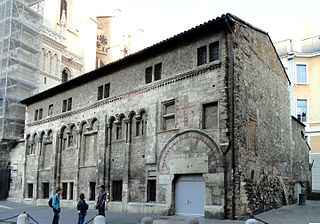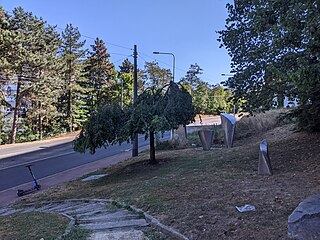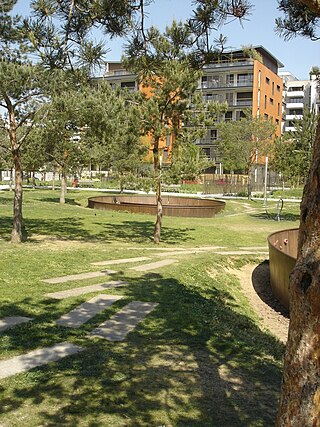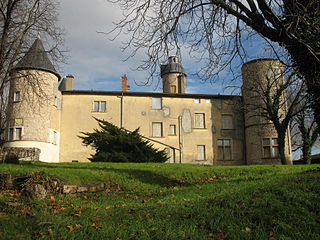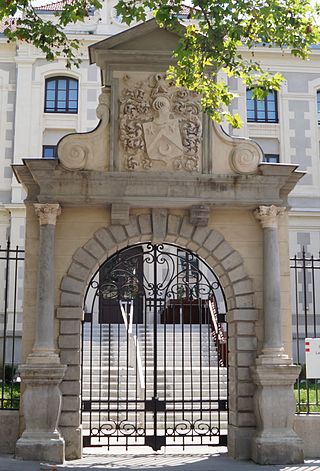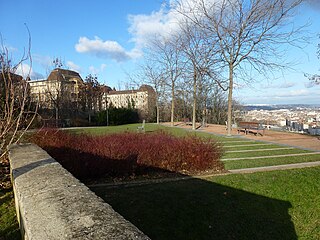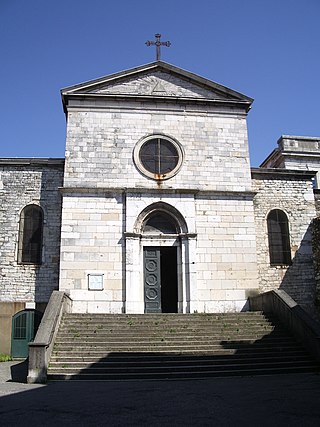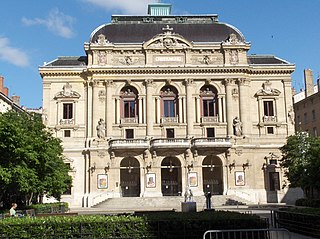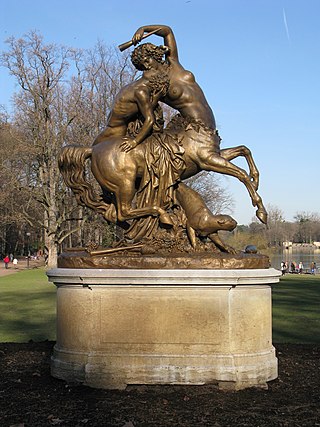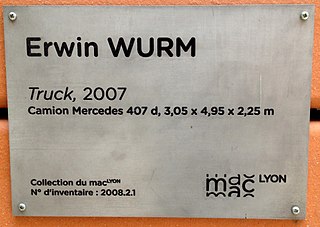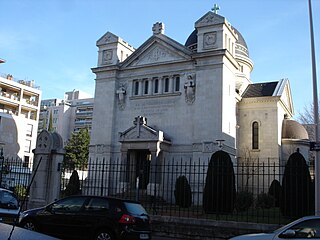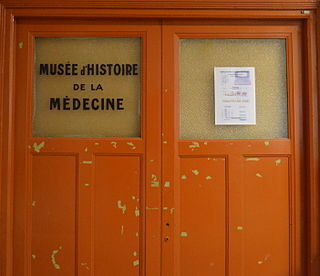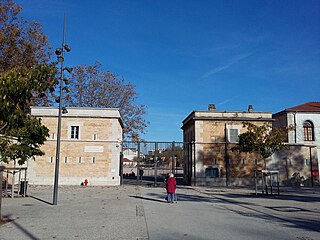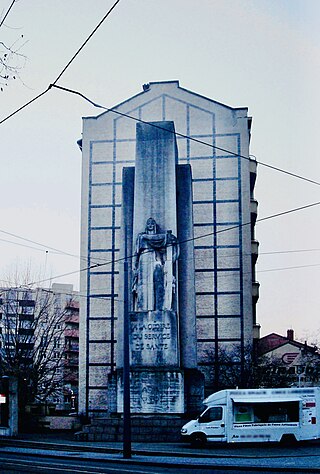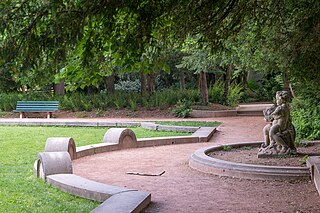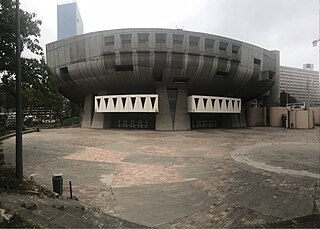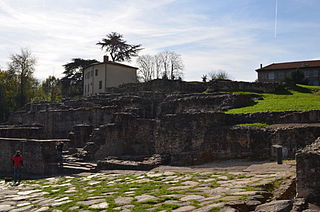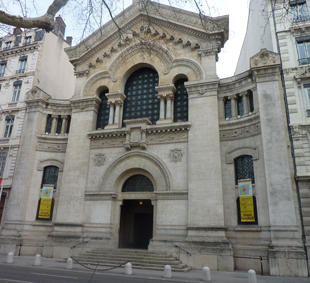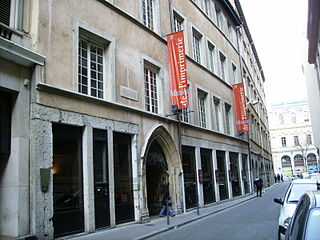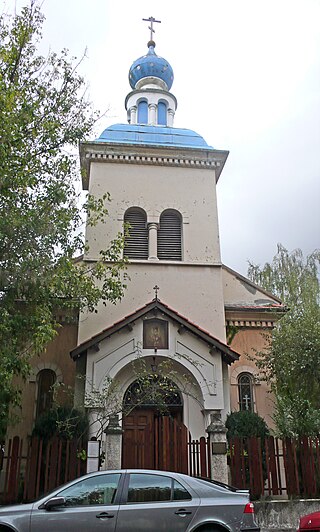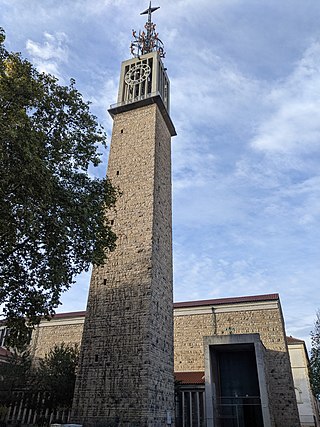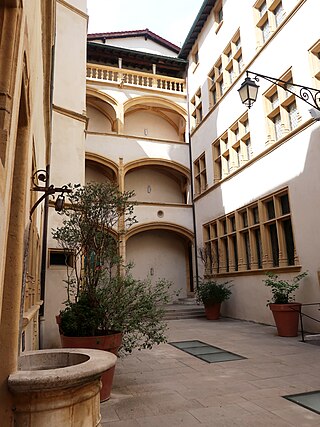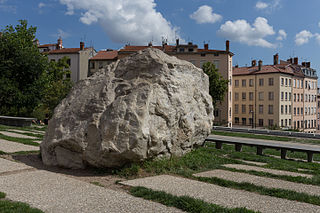90 Sights in Lyon, France (with Map and Images)
Legend
Premium Sights
Book tickets, guided tours and activities in Lyon.
Guided Free Walking Tours
Book free guided walking tours in Lyon.
Welcome to your journey through the most beautiful sights in Lyon, France! Whether you want to discover the city's historical treasures or experience its modern highlights, you'll find everything your heart desires here. Be inspired by our selection and plan your unforgettable adventure in Lyon. Dive into the diversity of this fascinating city and discover everything it has to offer.
Sightseeing Tours in LyonActivities in LyonThe Parc de la Tête-d'Or is a public urban park located in Lyon, one of the largest in France. The work of the brothers Denis and Eugène Bühler, the park was opened in 1857 while the work was not completed. It is exactly contemporary with New York's Central Park, created in the same year. The park was enriched with many buildings such as the large greenhouses in 1865, the velodrome, the guards' chalet and the park chalet in 1894, the fence in 1896, the collection greenhouses in 1899, the war memorial on Île aux Cygnes between 1914 and 1930 and the new rose garden between 1961 and 1964.
The Hôtel de Ville is the city hall of Lyon, France, and one of the largest historic buildings in the city. The building is located between the Place des Terreaux and the Place de la Comédie, in front of the Opéra Nouvel. It was designated a monument historique by the French government in 1886.
3. Galeries souterraines de la balme Saint-Clair
The "bones de poisson", also underground galleries of the Balme Saint-Clair or sometimes the Fantasques network, are a network of ancient galleries located under the Croix-Rousse plateau in Lyon. This archaeological site consists of galleries arranged in steps and all inclined towards the Rhône.
4. Chapelle de l'Hôtel-Dieu
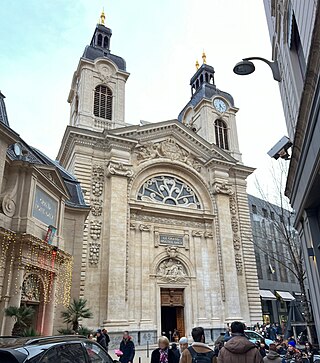
The Notre-Dame-de-Pitié Chapel, more commonly known as the Hôtel-Dieu Chapel, is a religious building located in the Bellecour district, in the 2nd arrondissement of Lyon, which belongs to the Hospices civils de Lyon. It is sometimes called the church of the Hôtel-Dieu because it is attached to the Basilica of Saint Bonaventure and previously to the parish of Saint-Nizier.
5. Musée des Beaux-Arts de Lyon
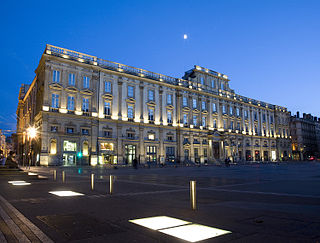
The Museum of Fine Arts of Lyon is a municipal museum of fine arts in the French city of Lyon. Located near the Place des Terreaux, it is housed in a former Benedictine convent which was active during the 17th and 18th centuries. It was restored between 1988, and 1998, remaining open to visitors throughout this time despite the ongoing restoration works. Its collections range from ancient Egyptian antiquities to the Modern art period, making the museum one of the most important in Europe. It also hosts important exhibitions of art, for example the exhibitions of works by Georges Braque and Henri Laurens in the second half of 2005, and another on the work of Théodore Géricault from April to July 2006. It is one of the largest art museums in France.
6. Basilique de Fourvière
The Basilica of Notre-Dame de Fourvière is a minor basilica in Lyon, France. It was built with private funds between 1872 and 1896 in a dominant position overlooking the city. The site it occupies was once the Roman forum of Trajan, the forum vetus, thus its name.
Wikipedia: Basilica of Notre-Dame de Fourvière (EN), Website
7. Cathédrale Saint-Jean
Lyon Cathedral is a Roman Catholic church located on Place Saint-Jean in central Lyon, France. The cathedral is dedicated to Saint John the Baptist, and is the seat of the Archbishop of Lyon. Begun in 1180 on the ruins of a 6th-century church, it was completed in 1476. Despite its long construction time, it has a relatively consistent architectural style. In 1998, the building, along with other historic sites in the center of Lyon, was inscribed on the UNESCO World Heritage List.
8. Halle Tony Garnier
The Halle Tony Garnier is an arena and concert hall in Lyon, France. It was designed by Tony Garnier in 1905. Originally a slaughterhouse, the building was renovated in 1987 and opened as a concert hall in 1988. With a standing capacity of nearly 17,000, it is the third biggest venue in France after the Accor Arena and Paris La Défense Arena.
9. Fontaine des Jacobins
The Place des Jacobins is a square located in the 2nd arrondissement of Lyon. It was created in 1556 and a fountain was added in 1856. The square belongs to the zone classified as World Heritage Site by UNESCO. According to Jean Pelletier, this square is one of the most famous in Lyon, because of its location in the center of the 2nd arrondissement and its heavy traffic, as 12 streets lead here. The square, particularly its architecture and its features, has changed its appearance many times throughout years.
10. Amédée Bonnet
Amédée Bonnet (20 March 1809 – 2 December 1858) was a French physician, surgeon at the Hôtel-Dieu de Lyon, and member of the Academy of Medicine. He is one of the forerunners of orthopedic surgery.
11. Jardin du Palais Saint-Pierre
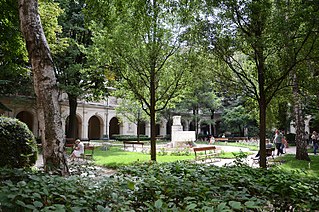
The garden of the Palais Saint-Pierre is a municipal garden in Lyon located within the walls of the Musée des Beaux-Arts de Lyon. It is part of a rectangle delimited by the arcades of the former cloister of the Benedictine abbey. Of regular style, it consists of lawns in half-moons or rectangulars, punctuated by vegetation and various sculptures. It is located in the city center on the peninsula. Like the Museum of Fine Arts, the garden is open every day, except Tuesdays and public holidays, from 10 a.m. to 6 p.m., and Fridays from 10:30 a.m. to 6 p.m.
12. Musée Cinéma & Miniature
The Musée Miniature et Cinéma, formerly the Musée des miniatures et sets de cinéma, is a private museum founded in 2005 by the miniaturist artist Dan Ohlmann. It is located at 60 rue Saint-Jean in Lyon, housed in the listed historic building of the former Maison des avocats. Since December 8, 2021, it has been managed by Julien Dumont.
13. Opéra de Lyon
The Opéra Nouvel in Lyon, France, is the home of the Opéra National de Lyon. The original opera house was re-designed by the distinguished French architect, Jean Nouvel between 1985 and 1993 in association with the agency of scenography dUCKS scéno and the acoustician Peutz. Serge Dorny was appointed general director in 2003.
14. Statue équestre de Louis XIV
The Monument to Louis XIV is a bronze equestrian statue of Louis XIV made by the sculptor François-Frédéric Lemot located on the Place Bellecour in Lyon, dating from 1825. It has been listed as a historical monument since 25 March 2016.
15. Villa Gillet
Villa Gillet is located in Lyon, in the Parc de la Cerisaie. It is a European and international house of contemporary writing. It gives a voice to writers, thinkers and artists. It is a cultural institution that is interested in all forms of culture: literature, humanities, political and social sciences, history, contemporary arts, etc. It brings together artists, writers, novelists and researchers from all over the world to feed a public reflection on the issues of our time during conferences, debates, round tables, and readings. The City of Lyon, the Metropolis of Lyon, the Auvergne-Rhône-Alpes Regional Directorate of Cultural Affairs, the National Book Centre and the Auvergne-Rhône-Alpes region contribute in part to its operation. From 1989 until 2019 it was managed by Guy Walter, who was also director of Subsistances.
16. Historic Site of Lyon
Vieux Lyon is the largest Renaissance district of Lyon. In 1964, Vieux-Lyon, the city's oldest district, became the first site in France to be protected under the Malraux law to protect France's cultural sites. Covering an area of 424 hectares between the Fourvière hill and the river Saône, it is one of Europe's most extensive Renaissance neighborhoods. There are three distinct sections: Saint Jean, Saint Paul and Saint Georges. In 1998, Vieux Lyon was inscribed on the UNESCO World Heritage List along with other districts in Lyon because of its historical importance and architecture.
17. Basilique Saint-Martin d'Ainay
The Basilica of Saint-Martin d'Ainay is a Romanesque church in Ainay in the Presqu'île district in the historic centre of Lyon, France. A quintessential example of Romanesque architecture, it was inscribed on the UNESCO World Heritage List along with other notable buildings in the centre of Lyon as a testimony to Lyon's long history as an important European town and unique blend of architectural styles.
18. Fontaine Bartholdi
The Fontaine Bartholdi is a fountain sculpted by Frédéric Auguste Bartholdi and realised in 1889 by Gaget & Gautier. It was erected at the Place des Terreaux, in the 1st arrondissement of Lyon, in September 1892.
19. Thermes Gallo-romains
The Ancient Baths of Lyon refer to several Roman thermal establishments located in Lyon, France. The most important of those discovered is that of the rue des Farges built on the side of the hill of Fourvière, possibly referred to as the baths of Apollo according to a tenuous set of clues.
20. Colline de Fourvière
Fourvière is a city district of Lyon, France, a hill immediately west of the old part of the town, rising from the river Saône. It is the site of the original Roman settlement of Lugdunum in 43 BC. The district contains many religious buildings including convents, monasteries and chapels. It is known in Lyon as "the hill that prays".
21. Amphithéâtre des Trois Gaules
The Amphitheatre of the Three Gauls of Lugdunum (Lyon) was part of the Sanctuary of the Three Gauls dedicated to the cult of Rome and Augustus celebrated by the 60 Gallic tribes when they gathered at Lugdunum. In 1961, it was classified as a monument historique.
22. Église Notre-Dame Saint-Louis
Notre-Dame Saint-Louis is a church assigned to Catholic worship, located in the Guillotière district, in the 7th arrondissement of Lyon, of which it is the oldest parish sanctuary. It is located at the intersection of Rue de la Madeleine and Grande Rue de la Guillotière.
23. Mausolée romain de Satrius
The tomb of Turpio is a Roman tomb that is part of a set of ten funerary monuments discovered on the outskirts of Lyon in 1885, during clearing work in the Saint-Just district. This ensemble is to be linked to the ancient necropolises of Trion.
24. Église Saint-Nizier
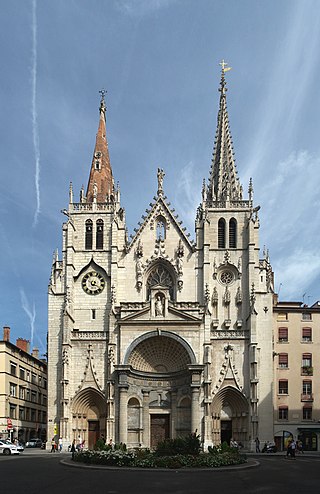
The Church of Saint-Nizier is a church in the Presqu'île district of Lyon, France, in the 2nd arrondissement, between the Place des Terreaux and the Place des Jacobins. Its name refers to Nicetius of Lyon, a bishop of the city during the 6th century. Begun in the 14th century and only completed in the 19th century, the church contains a variety of architectural styles, ranging from the neo-Gothic spire to the classical Renaissance facade. In 1998, it was inscribed on the UNESCO World Heritage List along with other historic buildings in Lyon.
25. Église Saint-Pothin
The Église Saint-Pothin is a Roman Catholic church located in Lyon, France. The parish church sits on the left bank of the Rhône, in the 6th arrondissement of Lyon, at the Place Edgar Quinet. By order of 2 May 2007, the whole church was included in the supplementary inventory of monuments historiques.
26. Théâtre de la Croix Rousse
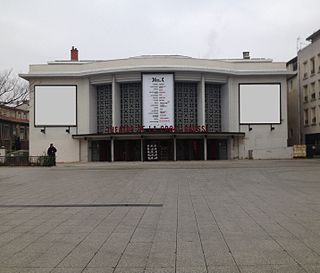
The Théâtre de la Croix-Rousse is a theater located in the 4th arrondissement of Lyon, on the Place Joannès-Ambre and built from the end of the 1920s. The designer of the place is Michel Roux-Spitz. In 1980, the architect Georges Bacconnier led a restoration of the interiors.
27. Théâtre Gallo-Romain de Fourvière
The Ancient Theatre of Fourvière is a Roman theatre in Lyon, France. It was built on the hill of Fourvière, which is located in the center of the Roman city. The theatre is part of a UNESCO World Heritage Site protecting the historic center of Lyon.
28. Lugdunum Musée et Théâtres Romains
Lugdunum, formerly known as the Gallo-Roman Museum of Lyon-Fourvière or Museum of Roman Civilisation, is a museum of Gallo-Roman civilisation in Lyon. Previously presented at the Museum of Fine Arts of Lyon and the Antiquarium, the municipal Gallo-Roman collection was transferred to a new building designed by Bernard Zehrfuss and opened in 1975, near the city's Roman theatre and odeon, on a hill known as Fourvière, located in the heart of the Roman city. Internally, it is formed of a concrete spiral ramp descending and branching out into the display rooms. It is managed and operated by the Metropolis of Lyon jointly with the archaeological museum of Saint-Romain-en-Gal. As well as displaying its own permanent collections of Roman, Celtic and pre-Roman material, a plan-relief of the ancient town and scale models of its major monuments such as the theatre and the Odeon, it also regularly hosts temporary exhibitions. On November 8, 2017, the museum was renamed Lugdunum.
29. Église Saint-Paul
The Église Saint-Paul is a Roman Catholic church located in Lyon, France. It is situated in the Vieux Lyon, in the Saint-Paul quarter, in the 5th arrondissement of Lyon. The cathedral is in the Romanesque and Gothic architectural styles. The tower-lantern was classified as monument historique in 1920, and the whole church was classified in 1996. In 2002, the church was completely renovated. It is around 45 m long and 16.5 m high under the arch.
30. Rampant du siphon des Massues
The Brévenne Aqueduct is one of the ancient aqueducts serving the ancient city of Lugdunum. The third aqueduct built in Lyon, it was 70 km long, and reached the Fourvière district in the current 5th arrondissement of Lyon. It owes its name to the river in the catchment area from which it was fed, the Brévenne.
31. Espace culturel du christianisme à Lyon
The Espace Culturel du Christianisme à Lyon (ECCLY), or Musée de l'Antiquaille, is an interpretation center for the history of Christianity located on the hill of Fourvière in Lyon, France, at 49 montée Saint-Barthélemy.
Wikipedia: Espace culturel du christianisme à Lyon (FR), Website
32. Église Saint-Georges
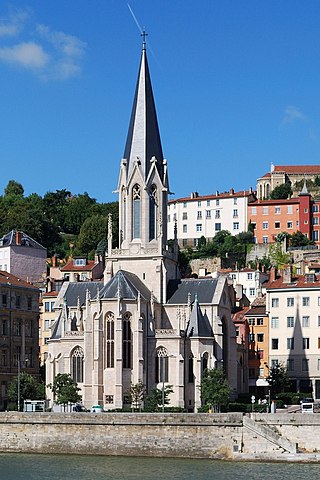
The Église Saint-Georges is a Roman Catholic church located on the Place François-Bertras, in the Vieux Lyon quarter, in the 5th arrondissement of Lyon. It is under the direction of the Primatiale parish and was named in honor of Saint George. The cathedral is near the Place Benoît-Crépu, between the quarter of the Quarantaine and Saint-Jean quarters.
33. Église du Bon-Pasteur
The Église du Bon-Pasteur is a Roman Catholic church located at rue Neyret on the slopes of La Croix-Rousse, near the montée de la Grande Côte, in the 1st arrondissement of Lyon. Cardinal Barbarin described the church as "highly symbolic for Lyon Christians".
34. Mémorial National de la Prison de Montluc

Montluc prison is a former prison located on rue Jeanne Hachette in the 3rd arrondissement of Lyon, France. It was known for being an internment, torture and killing place by the Gestapo during the occupation of France by the Nazis.
35. Musée des Confluences
The Musée des Confluences is a science centre and anthropology museum which opened on 20 December 2014, in the 2nd arrondissement of Lyon, (Rhône), France. In May 2011, the Musée des Confluences, while still under construction, received the designation “Musée de France” from the Ministry of Culture and Communication. It is located at the southern tip of the Presqu'île at the confluence of the Rhône and the Saône, adjacent to Autoroute A7, and comprises part of a larger redevelopment project of the Confluence quarter of Lyon. The deconstructivist architectural design, said to resemble a floating crystal cloud of stainless steel and glass, was created by the Austrian firm Coop Himmelb(l)au.
36. Aux enfants du Rhône défenseurs de la Patrie
To the Children of the Rhône, Defenders of the Fatherland, commonly known as the Monument of the Children of the Rhône, is a war memorial dedicated to the soldiers of Lyon who died during the Franco-Prussian War of 1870. It is located on the Place du Général-Leclerc at the entrance to the Parc de la Tête d'Or, called "Porte des Enfants du Rhône" in Lyon, France. The sculpture was made by the sculptor Étienne Pagny and was inaugurated on October 30, 1887.
37. Basilique Saint-Bonaventure
The Église Saint-Bonaventure is one of the churches of the quarter Presqu'île, located on the Place des Cordeliers, in the 2nd arrondissement of Lyon. This is the only medieval building not demolished after the creation of the rue Impériale, under the Second Empire by the prefect Claude-Marius Vaïsse.
38. Odéon
The Odeon of Lyon is a small ancient Roman theatre near the summit of the Fourvière hill in Lyon, France. It forms a pair with the Ancient Theatre of Fourvière, one of only two such pairs in Gaul. Along with other buildings in Lyon, it was inscribed on the UNESCO World Heritage List in 1998, protecting Lyon's long history as a powerful city and its unique architecture.
39. Veilleur de pierre
Stone Watcher is a sculpture by the sculptor Georges Salendre and the architect Louis Thomas, installed in 1948 at the intersection of rue Gasparin and place Bellecour in Lyon. It is a memorial to the French internal resistance recalling the assassination by the Germans of resistance fighters Albert Chambonnet, Gilbert Dru, Léon Pfeffer, René Bernard and Francis Chirat precisely at the location of the sculpture, on July 27, 1944.
40. Musée Africain
The African Museum of Lyon is the oldest museum in France dedicated to Africa and African art, and one of the oldest museums in Lyon. The collections specialise in West African objects. From 2012 to 2017, the museum was managed by a secular association, the Association du Musée Africain de Lyon. It closed on November 27, 2017. The space left free has been dedicated to the Carrefour des Cultures Africaines, which allows access to the library to be maintained.
41. Jardin Rosa Mir
The Jardin Rosa Mir is a garden located in the center of La Croix-Rousse quarter in the 4th arrondissement of Lyon, and created by Jules Senis. It is housed in a courtyard of the building at No. 83 Grande Rue de la Croix-Rousse. It can be accessed through a path located at No. 87 in the same street.
42. Église Saint-Polycarpe
The Église Saint-Polycarpe is a Roman Catholic church located in the 1st arrondissement of Lyon, on the slopes of La Croix-Rousse, between rue René Leynaud, rue Burdeau and passages Mermet and Thiaffait. It is the oldest church of the Oratory of Saint Philip Neri.
43. Église arménienne Saint-Jacques
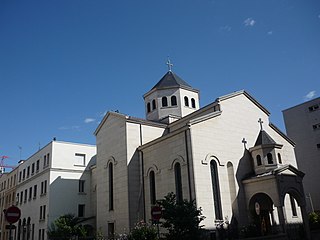
The Armenian Church of Saint-Jacques de Lyon or Surp Hagop Church is a religious building of the Armenian Apostolic Church located in the 3rd arrondissement of Lyon, at number 40 rue d'Arménie. The church is dedicated to James of Nisibis.
44. Musée d'Art Contemporain
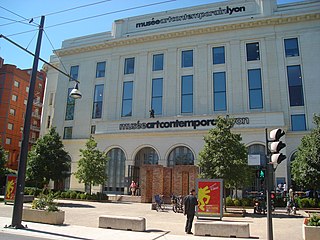
The Musée d'art contemporain de Lyon is a museum devoted to contemporary art, located in the 6th arrondissement of Lyon, in the Cité Internationale, next to the cinema, in front of the Parc de la Tête d'Or. It had over 42,000 visitors in 2007.
45. Temple du Change
The Temple du Change or Loge du Change, formerly used for the stock exchange of Lyon, stands in Vieux Lyon. It was originally built after plans by architect Simon Gourdet between 1631 and 1653, then rebuilt under the direction of Jacques-Germain Soufflot in 1748–1750. It has been assigned to Protestant worship since 1803, hence its designation Temple. As part of Vieux Lyon, the building was inscribed on the UNESCO World Heritage List along with other districts in the historic centre of Lyon.
46. Église Notre-Dame-Saint-Vincent
The Église Notre Dame Saint-Vincent is a Roman Catholic church located in Lyon, on the banks of the Saône, quai Saint-Vincent, in the 1st arrondissement of Lyon. In 1984, it was classified as monument historique.
47. Jardin Botanique
The Jardin botanique de Lyon, also known as the Jardin botanique du Parc de la Tête d'Or, is an 8 hectares municipal botanical garden located in the Parc de la Tête d'or in the 6th arrondissement of Lyon, France. It is open weekdays without charge.
48. Jardin des Chartreux
The Chartreux garden is a park in Lyon of about one hectare, located in the 1st arrondissement of Lyon on the slopes of the Croix-Rousse, on the Saône side and almost vertically above the river. The garden runs along the Cours Général-Giraud between the rue de la Muette and the Place Rouville. It is crossed by the Passage Gonin, a pedestrian path, which connects the Cours Général-Giraud to the Quai Saint-Vincent, along the Saône.
49. Site archéologique de Saint-Just Les Minimes
The Basilica of Saint-Just also known as Saint-Just basilica or the Maccabees Basilica was one of the oldest and most powerful churches in the city of Lyon until it was destroyed during the French Wars of Religion.
50. Église Saint-Étienne
The church of Saint-Étienne de Lyon, destroyed after the French Revolution, is probably the oldest church in Lyon. It belongs to the cathedral group of Lyon and is located north of the primatial church of Saint-Jean and south of the church of Sainte-Croix. It includes the ancient baptistery that adjoined the cathedral.
51. Basilique funéraire Saint-Laurent de Choulans
Saint-Laurent-de-Choulans is an archaeological site located in Lyon at the foot of the entrance to the Fourvière tunnel, and dates from the Merovingian period. This site includes the remains of a church surrounded by a fenced Christian necropolis, with an area of 0.5 to 1 ha.
Wikipedia: Basilique funéraire Saint-Laurent de Choulans (FR)
52. Maison des Canuts
The House of the Canuts is a museum located in Lyon, France. Emblematic of the Croix-Rousse district, it presents collections relating to the canuts, the silk workers of this district of Lyon, in particular functional looms, as well as elements related to the history of silk and its industry.
53. Démocrite méditant sur le siège de l'âme
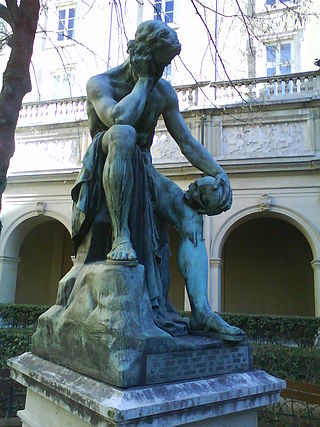
Democritus Meditating on the Seat of the Soul is a statue by Léon-Alexandre Delhomme (1841–1895), exhibited at the Paris Salon of 1868. It shows the Greek philosopher Democritus, his eyes fixed on a skull he holds in his hands. It is now exhibited in the garden of the Musée des Beaux-Arts de Lyon.
Wikipedia: Democritus Meditating on the Seat of the Soul (EN)
54. Église Sainte-Croix de Lyon
The Church of Sainte-Croix in Lyon is a Catholic religious building destroyed in the nineteenth century. It is the northernmost church of the Lyon episcopal group, including the Saint-Jean cathedral and the former Saint-Étienne church, and the remains of its foundations can be seen in the adjoining archaeological park.
55. Maison du Chamarier
The Maison du Chamarier, also known as Hôtel d'Estaing, is a house at 37 rue Saint-Jean in the 5th arrondissement of Lyon, at the corner of Rue de la Bombarde. It was built in 1498 but the ancient ruins are from the thirteenth century. From Latin cameriarus, the word "Chamarier" means the superintendent of the finances of the bishop of the Lyon Cathedral. He also owns the keys to the gates of the enclosure canonical. From the fifteenth century, he gathered the taxes collected during the fairs.
56. Cour des Voraces
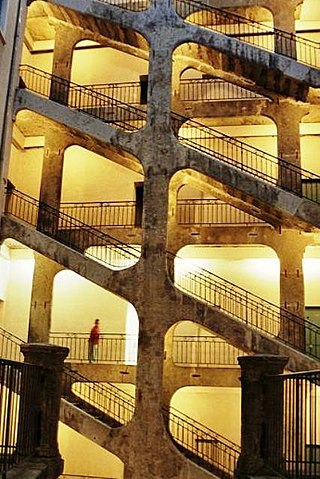
The Cour des Voraces, also called Maison de la République, is a courtyard building in the Pentes quarter, in the 1st arrondissement of Lyon, famous for its enormous six-floor stairway. It is an impressive traboule, a covered passage with entrances on Place Colbert, Montée Saint-Sébastien and Rue Imbert-Colomès.
57. Église Saint-Just
The church of Saint-Just or Saint-Just of the Maccabees church, is a church in Lyon, France. It is located at 41 rue des Farges, in Lyon and until 2014, the church hosted the "French-speaking Orthodox parish of the Holy Encounter", a parish of the Orthodox Byzantine rite dependent on the patriarchate of Constantinople.
58. Palais archiépiscopal
The Archiepiscopal Palace of Lyon, or Palais Saint-Jean, is a building of medieval origin located in the 5th arrondissement of Lyon. Home of the bishops and archbishops of Lyon for many centuries, it has undergone many developments. Confiscated during the Revolution, it was used from 1974 to store the municipal archives of Lyon.
59. Parc Henry-Chabert
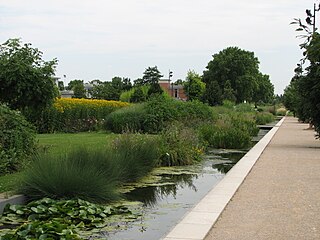
Parc Henry-Chabert, previously Parc de Gerland and also called Parc du Confluent, is a large greenspace in Lyon situated on a former industrial site in the south of the city near the confluence of the Rhône and the Saone. Construction began in 1996, and the park was developed over an area of 80 hectares. The initial two phases of construction concluded in 2000 and 2006, and were carried out by landscape architect Michel Corajoud. The project was managed by Grand Lyon. The park was renamed to Parc Henry-Chabert on 19 December 2020.
60. Statue de Monsieur Ampère
The Monument to Ampere is a statue erected on Place Ampère in the 2nd arrondissement of Lyon, France. Installed in 1888, it depicts the scholar André-Marie Ampère seated. Its sculptor was Charles Textor, its architect Joseph Dubuisson and the founder was Thiébaut.
61. Le Patineur
The Skater, or The Man of the Future or the Man of Freedom, is a sculpture by French artist César Baldaccini made in 1989. It has been located since 1992 on Place Tolozan, in the 1st arrondissement of Lyon, France.
62. Château de la Jayère
The Château de la Jayère was originally a pleasure house located in the 9th arrondissement of Lyon, known for its economic dynamism, the richness of its heritage and its quality of life. On the hillside, at the gateway to the Monts d'Or, the castle dominates the Saône plain facing the majestic Notre-Dame de Fourvière basilica.
63. Parc des Berges du Rhône
The Parc des Berges du Rhône is a 5.5 ha park in Lyon located in the Gerland district of the 7th arrondissement of Lyon. It creates continuity between the Henry-Chabert park, the Halle Tony Garnier and the banks of the Rhône through a pedestrian promenade whose design follows the curves of the slope, separating the low space from the high space, and a transverse cycle path.
64. Manécanterie
The Manécanterie is an ancient monument situated in Lyon in Saint Jean district, in the 5th arrondissement of Lyon. It is placed side by side to the south southwest of the cathedral Saint Jean and is a part of the former convent of the cathedral. This small Romanesque building served first as dining hall to the canons of Saint Jean, before becoming a parish choir school, namely a school for the singing of the clergy. In 1998, it was inscribed on the UNESCO World Heritage List along with other notable buildings in historic Lyon as a testimony to Lyon's long history and unique architecture.
65. Sculpture
Sculpture, sometimes nicknamed The Five Steel Menhirs, is a steel sculpture by Philolaos composed of five menhir-like elements. Since 1968, it has been installed in the garden of the Les Érables building in La Duchère, on the Boulevard de La Duchère (OSM) side.
66. Parc Jacob Kaplan
The Jacob-Kaplan Park or Parc de la Buire is a 5,000 m2 park in Lyon, located in the Buire district of the 3rd arrondissement of Lyon. It is named after Jacob Kaplan, a resistance fighter and then chief rabbi of France from 1955 to 1980. The park is marked in a significant way by hydraulic facilities and an artificial moat for rainwater infiltration.
67. Château de La Motte
Château de La Motte is a French castle that is also known as The castle of La Motte or just La Mothe. It is located in the 7th arrondissement of Lyon, on the left bank of the Rhône. It stands near the junction of two ancient roads of eastern and southern Lyon, on the border between the Dauphiné and Lyonnais. It occupies a small hill created in Gallo-Roman times for flood protection and because of good visibility.
68. Portail du Château de la Tourette
The Château de la Tourette was a pleasure residence located in the La Croix-Rousse district of Lyon. It was completely destroyed with the exception of the main door, which was classified as a historical monument by decree of 22 January 1910.
69. Jardin des Curiosités
Jardin des Curiosités is a 6,000-square-metre (65,000 sq ft) park in Saint-Just, Lyon. It is also called Jardin de Montréal, Belvédère Abbé Larue, Jardin de proximité Montréal and Jardin du Belvédère. It is situated at an altitude of 232 metres (761 ft) at the east end of place Abbé-Larue.
70. Église Saint-Irénée
The Saint Irenaeus Church, Lyon, located on the heights of Lyon in the neighborhood of St. Irenaeus, is one of the oldest churches in France. It is named for Irenaeus first Bishop of Lyon and Primate of Gaul.
71. Théâtre des Célestins
The Théâtre des Célestins is a theatre building on Place des Célestins in Lyon, France. It was designed by Gaspard André, and inaugurated in 1877, then in 2005. Alongside the Comédie-Française and the théâtre de l'Odéon, it is one of few theatres with over 200 years' continual usage in France. It is now a municipal theatre directly run by the City of Lyon. It has a contemporary and classical repertoire as well as producing new work.
72. Centauresse et Faune
The Centauress and the Faun or Centauresse and Faun is a sculpture by Augustin Courtet installed in the garden of the Palais Saint-Pierre in 1849 before being transferred to the Parc de la Tête d'Or near the Porte des Enfants du Rhône. The statue was cast by the Parisian founder Édouard Quesnel.
73. Truck
Truck is a sculpture made by Erwin Wurm, based on a work on a Mercedes 307 d truck. It was installed in front of the MAC Lyon at the Cité internationale in 2007. The rear of the truck is curved as if it had "adapted to the situation, with flexibility". In fact, the back joins the verticality of a wall.
74. Chapelle Sainte-Croix de Lyon
The Chapel of the Holy Cross or Chapel of the Missionaries of Notre-Dame is a Byzantine-style building located in the 6th arrondissement of Lyon. Raised in memory of the victims of the siege of Lyon in 1793, it belongs to the Commission of the Religious Monument of Brotteaux, an association under the law of 1901.
75. Musée d'histoire de la médecine et de la pharmacie de Lyon
The Museum of the History of Medicine and Pharmacy of Lyon is a museum of the history of medicine and pharmacy created in 1896 by Alexandre Lacassagne in Lyon, in the building of the Claude-Bernard-Lyon-I University on the banks of the Rhône. Confirmed by a decree by Raymond Poincaré in 1914, he moved in 1930 to the Rockefeller estate with the Faculty of Medicine.
Wikipedia: Musée d'histoire de la médecine et de la pharmacie de Lyon (FR)
76. Parc Sergent Blandan
Parc Sergent Blandan, also shortened to Parc Blandan, is an urban park in the 7th arrondissement of Lyon in Lyon, France, adjacent to Cimetière de la Guillotière Ancien. With an area of 17 hectares, the park opened to the public on 13 September 2013 at the location of Caserne sergent Blandan, a military barracks previously known as "Fort Lamothe".
77. Monument à la gloire du service de santé militaire
The monument to the glory of the military health service of Grange Blanche is a monument located in the 8th arrondissement of Lyon that commemorates the action of medical soldiers from the Army Health School during the conflicts of the twentieth century.
Wikipedia: Monument à la gloire du service de santé militaire de Grange Blanche (FR)
78. Parc de la Cerisaie
The parc de la Cerisaie is an urban park in the Croix-Rousse 4th arrondissement of Lyon, France. It is partially situated on a slope, leading from the plateau of the Croix-Rousse down towards the river Saône.
79. Auditorium Maurice-Ravel
The Maurice Ravel Auditorium is a concert hall located in Part-Dieu, the 3rd district of Lyon. It was originally built for the National Orchestra of Lyon and is their residence hall. It is also one of the first buildings in France to be built with Prestressed concrete.
80. Temple de Cybèle
The basilical insula is the name given by its inventor Amable Audin to a site that hosted several Roman constructions, in the ancient district of Fourvière in Lyon, France. Overlooking the ancient theatre, it was excavated from 1925 onwards by several archaeologists and then largely excavated by Audin between 1965 and 1978. The identification of the ruins discovered has been the subject of various interpretations, both historical and speculative, but its purpose remains unknown. Thus, many names have been conferred on this complex space, including the Augustan basilical insula, the temple of Cybele, the sanctuary of Cybele, Agrippa's praetorium and the governor's palace.
81. Église de l'Annonciation
The Annunciation church is a Greek Orthodox church located in Lyon rue d'Athenes in the 7th arrondissement. It depends on the patriarchy of Constantinople and the Greek Orthodox Metropolis of France. It is dedicated to the Annunciation.
82. Grand Temple
The Grand Temple de Lyon, also known as the Temple des Brotteaux, is a Protestant place of worship located on the left bank of the Rhône, 3 quai Victor-Augagneur, in the 3rd arrondissement of Lyon. The parish is a member of the United Protestant Church of France.
83. Musée de l'Imprimerie et de la communication graphique
The Museum of Printing and Graphic Communication is one of the museums in Lyon whose main missions are to enrich, preserve, document and promote the book and graphic heritage to various audiences. Created in 1964, it is located in the Hôtel de la Couronne, at 13, rue de la Poulaillerie in the 2nd arrondissement of the city.
Wikipedia: Musée de l'imprimerie et de la communication graphique (FR), Website, Website
84. Église orthodoxe russe Saint-Nicolas
The Church of St. Nicholas is a Russian Orthodox religious building located at 5, rue Sainte-Geneviève, in the 6th arrondissement of Lyon, in the Brotteaux district. It is an Orthodox church of the Russian Orthodox Church Outside of Russia - Synod of Metropolitan Agafangel since the parish left the Synod of the Russian Orthodox Church Outside of Russia in 2001 of Metropolitan Lavr.
Wikipedia: Église orthodoxe russe Saint-Nicolas de Lyon (FR)
85. Église Saint-Augustin
The Saint-Augustin church, a building used for Catholic worship, is located in the 4th arrondissement of Lyon, at the intersection of Denfert Rochereau and Jacquard streets. It is the most recent parish sanctuary in the district, with the exception of the Sainte-Élisabeth church.
86. Église Notre-Dame de l'Annonciation
The Church of Notre-Dame-de-l'Annonciation is a church assigned to Catholic worship located on Place de Paris, opposite the Vaise train station, in the 9th arrondissement of Lyon, of which it is a "real visual signal".
87. Hôtel Bullioud
The Hotel Bullioud is a private mansion on the rue Juiverie in Lyon. He is known for the gallery of Philibert Delorme built following his trip to Italy (1536). Its decoration is one of the first experiments in France with the Renaissance style.
88. Musées Gadagne
Gadagne and its two museums form a museum complex in Lyon, France. Located in the 5th arrondissement in the Saint-Jean district, one of the three districts of Old Lyon with Saint-Paul and Saint-Georges, it is located in the Hôtel des Pierrevive, renamed "Hôtel de Gadagne". Gadagne is home to two museums of France, the MHL - Musée d'Histoire de Lyon and the MAM - Musée des arts de la Marionnette, a small theater with a program of puppet theater shows and lectures, a shop, a café-restaurant, and a hanging garden overlooking the city.
89. Le Gros Caillou
The Gros Caillou is one of the symbols of the Croix-Rousse district in Lyon, France. Erected as a stele, this massive very hard grey-white rock of 24 t, is a quartzite whose mineralogical composition shows that it was transported from the Alps to Lyon by glaciers: this is what is called an erratic block.
90. La Tour Rose
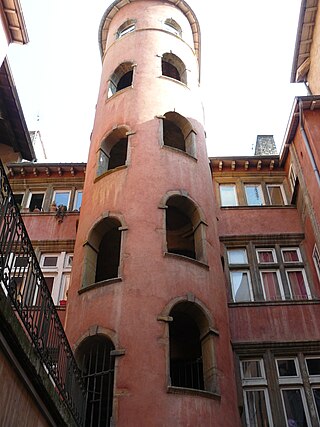
The Maison du Crible, also known as the "pink tower" because of its ochre-colored staircase, is a building located at 16 rue du Bœuf, in the 5th arrondissement of Lyon, France. Located in the heart of Old Lyon (Saint-Jean), it is one of the most remarkable buildings in the district because of its ochre color, the tower that adorns it and gives it its name. The most illustrious of the residents was the King of France Henri IV, who stayed there for a few days in 1600, when he married Marie de Medici, celebrated less than 300 meters from the house, at the primatial church of Saint-Jean. It has been classified as a historical monument since 1937. It is home to the French Orthodox parish. The restaurant La Tour rose, originally on the ground floor of the building and now moved to another address on rue du Bœuf, takes its name from the stair tower.
Share
How likely are you to recommend us?
Disclaimer Please be aware of your surroundings and do not enter private property. We are not liable for any damages that occur during the tours.
